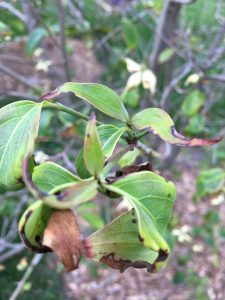
I have 4 Kousa dogwoods that have bloomed beautifully the last 3 years. I definitely dying, 1is sort of OK and is blossoming and the other 2 look I’ll. The leaves are shriveling and the flower and leaf has this rusty spot on the ends.
Thank you for contacting the Toronto Master Gardeners with your inquiry.
Dogwood is a very popular ornamental tree with its flowering bracts, elegant foliage, and bright red fruits.
These beautiful trees require fertile, moist soil with good drainage. They are understory trees and require dappled lighting with protection from the hottest rays of the day. But even plants with good site conditions, annual fertilizer and adequate water may still encounter problems that destroy their health and vigor.
There are a number of fungal and bacterial diseases which affect this plant especially during extended periods of high humidity and frequent rains. We have definitely seen an increase in the number of bacterial and fungal undections this year due to our extremely wet spring.
From your photo it is difficult to say with 100% certainty which of the fungal diseases could be affecting your trees.
Spot Anthracnose is caused by the fungus Elsinoe corni. According to Clemson College of Agriculture ” The flower bracts are usually attacked first and then the leaves, young shoots and fruit of dogwoods, primarily during wet spring weather. Symptoms are small (⅛ inch), tan spots with reddish-purple borders. When infection is severe, these spots can cause flower bracts and leaves to become wrinkled and distorted. As further infections occur, individual spots eventually merge to form larger spots. The centers may drop out. This fungus survives from year to year on infected twigs, fruits and other tissues.” In most cases this disease doesn’t result in significant damage, but severe and repeat infections each year can significantly weaken a tree. Make sure to clean the area under the tree and remove any infected fallen leaves. Do not put the leaf litter in your compost bin, instead put it in the garbage. Thin the canopy to increase air movement. Planting species and cultivars with some degree of disease resistance such as Kousa dogwood (Cornus kousa) ‘National’, ‘Milky Way Select’ and (C. florida) ‘Cherokee Brave’, ‘Cherokee Chief’, ‘Welch’s Bay Beauty’, ‘Cherokee Princess’ and ‘Springtime’ is an excellent option for managing this problem in the landscape.
Cercospora & Septoria Leaf Spots are caused by the fungi Cercospora cornicola and Septoria species, respectively. They most commonly occur during the wet summer months, and may become so numerous that they cover the leaves by the end of summer. Heavily spotted leaves may be shed early. The light spotting seen on leaves of dogwood usually has little impact on tree health, but repeated years of early leaf drop can weaken the tree. Spots caused by Cercospora species have tan-brown areas with diffuse borders. Septoria leaf spots are a dark brown purple in color, later developing light brown or gray centers with dark borders. Clean up and dispose of infected leaves on the ground and on the tree, if possible, since this is where these fungi survive the winter.
For a comprhensive list on Dogwood diseases refer to Dogwood Diseases and Insect Pests

